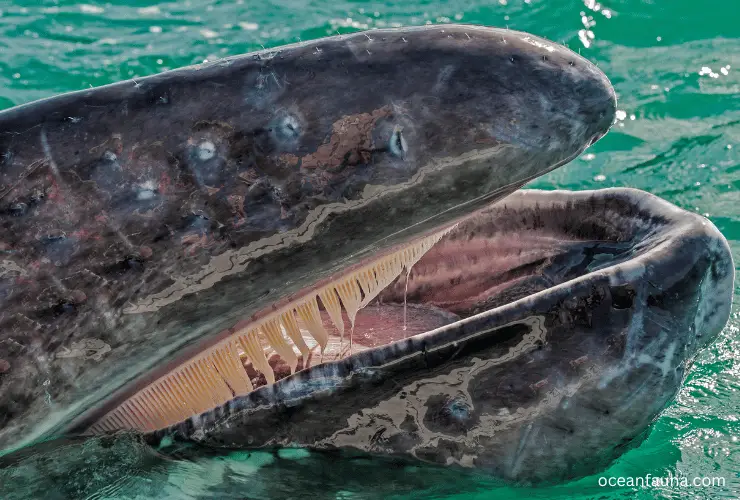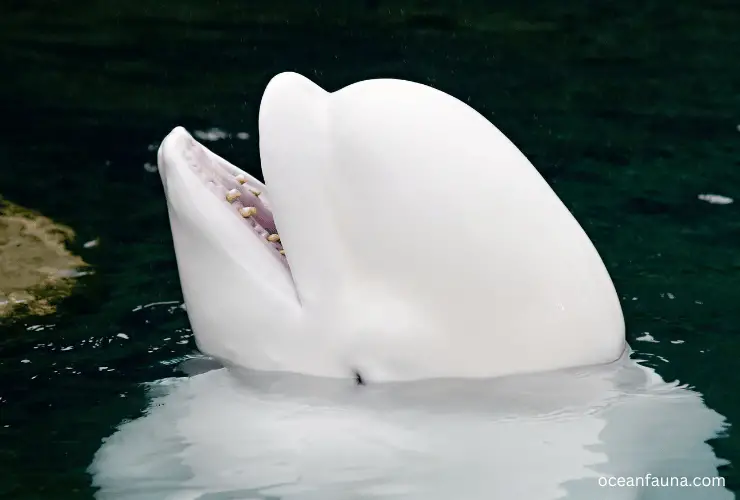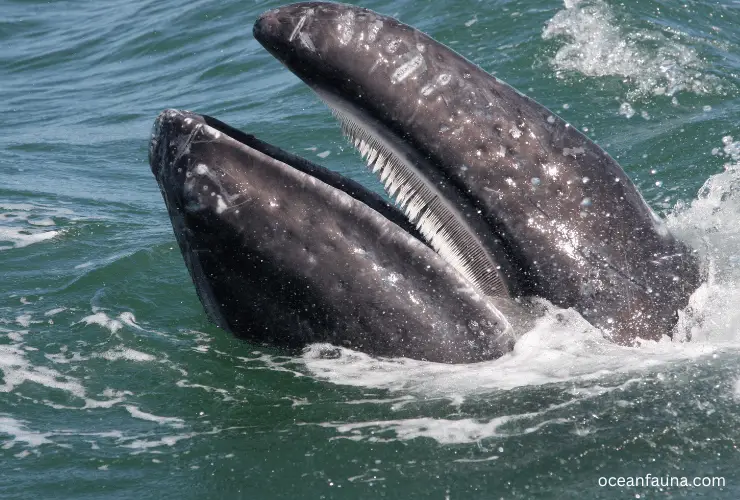While not all whales boast sharp teeth, many do indeed have them. Interestingly, however, some whale species are equipped with an apparatus known as baleen—a filter-like mechanism that serves the same purpose as teeth would.
This comprehensive article will uncover the intriguing fact of which whales possess teeth and which do not.
Do Whales Have Sharp Teeth?
When it comes to denticles, whales can be divided into two distinct subgroups: Mysticeti and Odontoceti. The former has baleen instead of teeth, while the latter possesses sharp incisors that are unmistakably visible.
Which Whales Have Baleen Instead of Teeth?
Mysticeti whales, such as Blue, Gray, Humpback and Right whales, are particularly known for their baleen plates instead of traditional sharp teeth.
The Blue Whale is the largest mammal on Earth and has baleen plates which can measure up to 8 feet (2.4 meters) in length and have several hundred fringed overlapping plates.

Grey Whales have between 270-400 pairs of baleen plates in their mouths as adults, which they use to filter plankton from seawater and are known for migrating yearly between summer feeding grounds in the Arctic Ocean and winter breeding grounds in the warmer seas of Mexico and Central America.
Humpback Whales also have long baleen plates – up to 2m – along with a series of shorter fringe-like bristles that help them strain krill, copepods, shrimp, small fish and other zooplankton from the ocean water.
Lastly, Right Whales have over 300 pairs of bristle-like fringed plates which they use to strain tiny organisms such as copepods, krill and other zooplankton from the ocean water.
All Mysticeti whales rely heavily on these baleen plates for feeding as they lack teeth or jaws like other whales.
Moreover, these four species are all relatively passive creatures with large brains compared to other marine mammals, making them highly intelligent when navigating the Earth’s oceans.
Which Whales Have Teeth?
The whales with teeth are known as Odontoceti whales, including the Sperm whale, Orca, Beluga, and Narwhal. These toothed whales have sharp teeth that they use for a variety of purposes, including hunting for food and defending themselves from predators.

Sperm Whale teeth are arranged in rows with up to 40-52 conical-shaped teeth in each jaw. They primarily hunt squid using their highly adapted echolocation system.
Orcas also have remarkable teeth; each one of their 40-50 cone-shaped teeth can be between 2-4 inches long. They primarily feed on fish, squid or marine mammals like seals and sea lions, using their strong jaws to tear apart the prey.
Belugas also have up to 400 peg-like teeth in their upper and lower jaws, which are used for consuming food such as fish, shrimp, crabs, molluscs and other invertebrates found near the ocean floor.
Lastly, the Narwhal has a single long tusk protruding from its face, used primarily for showmanship among males during breeding season as well as defence against predators like killer whales or polar bears. They also have small tooth cusps on both sides of the tusk’s base, which they use to feed on fish and other seafood.
The Odontoceti family is a fascinating group of toothed whales that display amazing adaptations in order to survive in their aquatic environment. Their diverse range of tooth shapes allows them to consume a wide range of prey items depending on what is available according to their migration patterns; this helps ensure that these species will remain viable for years to come.
How Sharp Are a Whale’s Teeth?
Most whales have teeth that are sharp enough to effectively catch and consume their prey. The sperm whale, for example, has long and sharp teeth in its lower jaw, which it uses for hunting squid and other sea creatures. The Narwhal also has a single spiral tusk which is believed to be used for sensing prey as well as for competing for mates.
Even (Mysticeti) baleen whales, which don’t use their teeth to feed but instead filter krill from the water with specialized baleen plates in their mouths, possess pairs of razor-sharp peg-like teeth along their upper and lower jaws.

Orcas have similarly sharp teeth that are adapted to grab and tear food into smaller pieces so they can swallow it more easily. These sharp teeth can easily pierce through the flesh of other marine animals, such as seals and sea lions, helping them hunt efficiently. Killer whales also have powerful jaws that enable them to crush clams or even sea turtles with relative ease.
Whales possess a range of tooth shapes that depend on their diet or feeding habits – species such as sei whales and blue whales feed by gulping large amounts of krill-filled water and then forcing it out through the baleen plates, while species like the pilot whale eat mainly fish and squid and therefore have long pointed teeth adapted for catching slippery prey.
Baleen whales usually have flat plough-like molars adapted for crushing crustaceans such as shrimps, while some species (such as right whales) lack any functional teeth at all.
Over millions of years, natural selection has designed a variety of whales with highly effective dental systems to consume whatever food sources are present in their habitats. Killer whales have the sharpest set of teeth among all marine mammals, allowing them to feast on anything swimming near them!
How Do Whales’ Teeth Work?
Like most other mammals, whales have teeth used for feeding. Their teeth come in a variety of sizes and shapes and can range from cone-shaped to curved or flat. Whales may have anywhere from 20 to several hundred teeth depending on the species.
Most whale species use their teeth to grab and hold prey, while some do not use them but instead swallow whole food. The size and shape of a whale’s teeth depend on its diet; baleen whales, which feed primarily on plankton, have rows of short, comb-like baleen plates that act like a sieve.
Toothed whales, such as sperm whales and killer whales, use their teeth to bite off chunks of large prey such as fish or squid. They may also use their teeth for defence against predators. The sharp edges of their conical teeth are effective for gripping slippery animals as well as inflicting serious wounds if necessary to protect themselves or their young.
A feature unique to certain types of a whale is the presence of an upper row of ‘vestigial’ teeth – these are located behind the jawbone but never erupt into the mouth. These extra sets are thought to be used as reinforcement during feeding activities or mating behaviours by some species.
Whales don’t typically use oral hygiene products as humans do; however, they instinctively brush their teeth with sand or gravel found on the ocean floor when they open their mouths wide enough for it to get inside, performing a kind of natural dental cleaning process for them.
Whale gums may also harden over time due to abrasive particles from the seafloor, which can help protect them from infections caused by bacteria and parasites living in their environment.
Conclusion
Whales are equipped with an assortment of teeth, evolved for different objectives. Some rely on their fangs to capture prey, whereas others use baleen plates as a substitute. Among all marine mammals, killer whales boast the sharpest set of chompers allowing them to easily gobble up any creature that swims close by.
Through evolution and natural selection, whales have developed a range of dental systems over millions of years, enabling them to feed and defend against predators. For instance, toothless species use suction for sustenance, while others depend on their teeth as protection from danger.

5 thoughts on “Do Whales Have Sharp Teeth? [Explained]”